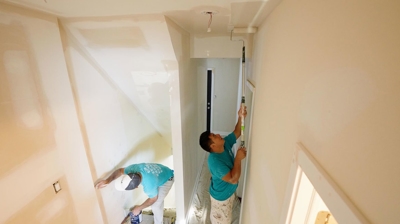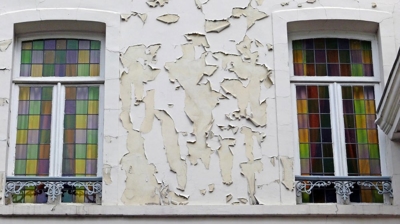How Long Paint Really Takes to Dry?
After pouring hours (or money) into an extensive paint job, the last thing you want to do is touch it too early, and cause smudges, texture, or peeling.
How long paint takes to dry is a tricky question to answer because there are many factors that can affect drying time. To give as correct an answer as possible, we’ll need to consider the type of paint you’re using, the temperature and humidity of the room or weather, and even the type of surface you’re painting. Each of these factors can affect how long it takes for the paint to dry.
In this blog, we’ll discuss the types of paint, how they dry, and other factors that affect drying time, so let’s dive in.
Types of Paint
Paint is available in four basic types: water-based latex, oil-based, shellac, and lacquer. Each type of paint has different properties that will affect drying times.
- Latex paint is a water-based paint made with acrylic resins. It’s the most popular paint for both home interiors and exteriors because it is inexpensive, durable, and easy to work with. Latex paint dries more slowly than other types of paint, usually taking about four hours to dry completely.
- Oil-based paints have been around for centuries and were once the only type of paint available. These paints are made with alkyd or linseed oils and take longer to dry than latex paints. They’re also more difficult to work with, so unless you’re experienced in painting, it’s best to leave oil-based paints to the professionals. Oil-based paint dries slowly, usually taking about six hours to dry completely.
- Shellac is a resin-based paint made from alcohol and lac bug secretions. It dries very quickly, usually in about 30 minutes, but it isn’t very durable. Shellac is mostly used for priming, sealing away odors, or painting out of reach trim and other small projects like wall murals.
- Lacquer is a quick-drying paint made with either nitrocellulose or synthetic resins. It dries in about 30 minutes and is exceptionally durable, making it an excellent choice for painting trim and other high-use areas. Lacquer often requires several coats to achieve the desired finish, so be sure to wait more than 30 minutes for the first coat to dry to the touch before attempting a second coat.
Why Some Paints Take Longer
It’s a common misconception that all paint dries at the same rate. In reality, different types of paint and finishes can have vastly different drying times. The type of paint you’re using, the thickness of the paint coat, the temperature and humidity of your environment, and the type of surface you’re painting all affect how long it will take for your paint to dry.
As mentioned above, latex paints tend to dry more quickly than oil-based paints. Likewise, a thick coat of paint will take longer to dry than a thin coat. When it comes to temperature, painting in a hot, dry environment will usually result in quicker drying times than painting in a cold, damp environment.
The best temperature for paint to dry is between 50 to 90 degrees. Any cooler and the paint will take ages and not apply uniformly, and any hotter, and the paint will dry too quickly, which could cause more texture, clumping, and stickiness.
Within this safe range, you may notice that different rooms in your home dry at different rates depending on the amount of direct sunlight they get, and how high the air conditioning is. A good rule of thumbs is to always add an hour of drying time to the estimate based on any complicating factors we mention below.
What Factors Affect Drying Time
The following factors are the most common culprits when it comes to extending the time your paint takes to dry. Be sure to add some time to your drying estimate if you think any of these could affect your paint job. It’s always better to be safe than sorry and avoid sanding down unwanted texture between coats.
- The type of paint: The type of paint you use will have a significant impact on how long it will take to dry. Water-based paint will dry much quicker than oil-based paint, for example. If you’re unsure of your paint base, most paint manufacturers supply an estimate for how long the paint should take to dry.
- The color of the paint: Darker colors will usually take longer to dry than lighter colors. This is because they have more pigment and need more time to set.
- The surface being painted: If you’re painting a porous surface like wood, it will absorb the paint and take longer to dry. A non-porous surface like glass will dry much quicker and likely require less paint.
- The temperature and humidity of the room: The temperature and humidity of the room can also affect how long the paint will take to dry. The paint will take longer to set if it’s too cold or humid. Hot and dry rooms will make the paint dry quicker.
- The thickness of the paint: If you use thicker paint, it will take longer to dry than a thinner coat. This is because there’s more paint on the surface, so it needs more time to set. It may be wiser to use several thin coats of paint for an even finish without texture.
Whether or not a primer was used: Using a primer can help the paint to dry quicker because it provides a smooth surface for the paint to adhere to. Without primer, the paint may take longer to dry, especially if your walls are made of a porous material.
Ventilation: You should always make sure the room is well-ventilated when painting. The paint will take longer to dry if there’s not enough air circulation. Installing fans, opening windows (always with a screen to avoid unwanted debris) and leaving doors open can all help paint dry more uniformly.
How to Speed Up Drying Time
It’s always frustrating to wait for the paint to dry, but the best choice is always to be patient. While you can attempt these methods below, there is always a chance of error that could ruin your arduous work. If you’re in a hurry, here are a few tips to speed up the process:
- Use a hair dryer on the low or cool setting. Hold it more than six inches from the surface and never touch the wall with the dryer or move it closer than six inches. Move the hairdryer around continuously so you don’t overheat any area and cause bubbles. Only use this method as a last resort.
- Turn on a fan. This will circulate the air and help the paint dry faster.
- If it’s sunny outside, open the windows to let in some fresh air. The natural light and breeze will speed up the drying process.
- Use a space heater on the low setting. Again, keep it moving, so you don’t overheat the paint, and do not leave it too close to the wall, unattended, or on a high setting.
Invest in Painting That Lasts
A great paint job should hold up for years, not months. Our painters deliver smooth, even coverage with expert attention to detail. Call (844) 394-8660, or fill out this form to schedule your free consultation and get a free estimate.






